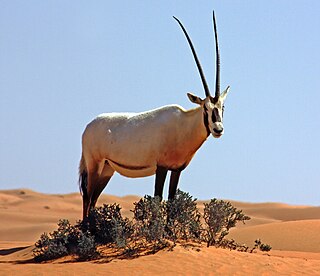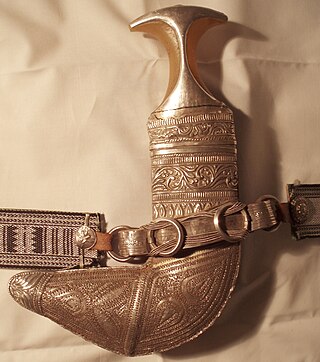
Oman, officially the Sultanate of Oman, is a country on the southeastern coast of the Arabian Peninsula in West Asia. It overlooks the mouth of the Persian Gulf. It shares land borders with Saudi Arabia, the United Arab Emirates, and Yemen. The capital and largest city is Muscat. Oman has a population of about 5.28 million as of 2024, which is a 4.60% population increase from 2023. and is the 123rd most-populous country. The coast faces the Arabian Sea on the southeast, and the Gulf of Oman on the northeast. The Madha and Musandam exclaves are surrounded by United Arab Emirates on their land borders, with the Strait of Hormuz and the Gulf of Oman forming Musandam's coastal boundaries.

The national emblem of Oman is Janbiya Bo Sayfain, an insignia consisting of a Janbiya inside its sheath that is superimposed upon two crossed swords. Adopted in the 18th century as the badge of the Omani royal family, it subsequently became the national emblem of the Sultanate of Oman. The emblem is featured at the canton on the Flag of Oman.

The Arabian oryx or white oryx is a medium-sized antelope with a distinct shoulder bump, long, straight horns, and a tufted tail. It is a bovid, and the smallest member of the genus Oryx, native to desert and steppe areas of the Arabian Peninsula. The Arabian oryx was extinct in the wild by the early 1970s, but was saved in zoos and private reserves, and was reintroduced into the wild starting in 1980.

The Omani rial is the currency of Oman. It is divided into 1000 baisa.
Oman Air is the flag carrier of Oman. Based at Muscat International Airport in Muscat, it operates domestic and international passenger services, as well as regional air taxi and charter flights.

A national personification is an anthropomorphic personification of a state or the people(s) it inhabits. It may appear in political cartoons and propaganda.

A khanjar is a traditional dagger originating from the Sultanate of Oman, although it has since spread to the rest of the Middle East, South Asia and the Balkans. Worn by men for ceremonial occasions, it is a short curved blade shaped like the letter "J" and resembles a hook.

Duqm is a port town on the coastal strip of the Arabian Sea open to the Indian Ocean. It is about 550 km from Muscat. As of 2017, the population was approximately 12,000.
The Banu Awf, today known as Al Aufy and various spellings such as Al Aufi, Al Oufi, Al Awfi, and Al Awfy is an ancient Arab tribe with a significant historical influence in the Arabian Peninsula, particularly in Oman. The tribe is renowned for its diverse lineage and contributions to the sociopolitical and cultural landscape of the region. The tribe's symbol is the poisonous oleander, symbolising their resilient ability to survive and danger when provoked. The largest concentration of the Al Aufy tribe is in Oman, specifically in Wadi Bani Awf, an ancestral valley that holds cultural and historical importance and is today a popular tourism destination known for its rugged beauty and outdoor recreation opportunities.

The culture of Oman describe the cultural aspects of people living in Oman, which is steeped in the religion of Islam. Oman has its own unique subsect of Islam, known as Ibadhism, however other strands of Islam such as Sunni and Shi'a are also practised. The Islamic month of fasting, Ramadan, and other Islamic festivities are very important events in the Omani culture.

Nepal, officially the Federal Democratic Republic of Nepal, is a landlocked sovereign state located in South Asia. It is bordered by two countries: China by the north and India by the east, west and south. It borders the Himalayas including the highest peak, Mount Everest, which is also the highest point on Earth. The Government of Nepal had officially adopted several national symbols such as Nepali as the language, the national flag featuring the Himalayas with the Sun and the Moon, rhododendron as the national flower, crimson as the national colour, the Himalayan monal as the national bird, and cow as the national animal.
A thawb is an Arab garment mainly worn by inhabitants of the Middle East and North Africa. The thawb is long-sleeved ankle-length traditional robe; it is worn by men and women with regional variations in name and style. Depending on local traditions, a thawb can be worn in formal or informal settings; in the Gulf states thawbs are the main formal attire for men. It is also worn by Muslim men in the Indian subcontinent due to its modest appearance, and is believed to be a sunnah, and it is commonly referred to as a jubbah there. The etymology of the word “thawb,” the history and origin of the robe, its regional styles and versions, and its modern use help to characterize and differentiate the thawb from other traditional Arabic clothes.
Multiple symbols have been developed to represent lacto-vegetarianism and veganism. Several are used on food packaging, including voluntary labels such as The Vegan Society trademark or the V-Label as well as the vegetarian and non-vegetarian marks mandated by the Indian government. Symbols may also be used by members of the vegetarian and vegan communities to represent their identities, and in the course of animal rights activism.
National symbols of Switzerland are the symbols used to represent Switzerland. As of 2020 the Swiss legislature has made three Swiss national symbols official, a flag, coat of arms, and anthem, but various other symbols are used as well to represent the Swiss people.
The national symbols of Bahrain are official and unofficial flags, icons or cultural expressions that are emblematic, representative or otherwise characteristic of Bahrain and of its culture.
The national symbols of Cyprus are official and unofficial flags, icons or cultural expressions that are emblematic, representative or otherwise characteristic of Cyprus and of its culture.

The national symbols of Iraq are official and unofficial flags, icons or cultural expressions that are emblematic, representative or otherwise characteristic of Iraq and of its culture.














